Jeremie Averous's Blog, page 27
June 18, 2020
How Sexy Startups Can Also Sometimes Be Toxic Workplaces
Startups are trendy and many young people dream working there in all the excitement of creating something that will change the world. Still some startups are also incredibly toxic places to work, as reminds us this Gapingvoid post ‘Beware Supersexy‘.

The point is particularly important to make because startups are by essence, stressful places to be where a substantial commitment is expected from employees, and change is prevalent on a daily basis as the venture grows, pivots and struggles. Like in projects, the pace of action is quick and some employees can sometimes feel overwhelmed.
Some examples have recently come to light of cultures of mental and even sometimes sexual harassment, and more benignly of certain toxic work cultures in some startups even some that were very much under the public eye and heavily funded.
It is not rosy everyday in startups, and the strong will that is needed from founders do not always translate in a nice way to work. At the same time I do know a number of startups that have developed very nice ways to work together and where employees are incredibly happy to the part of the adventure.
It’s just a fact that startups, like other organisations, can sometimes be toxic places to work, and that because of the specific pace it can be quite extreme. Startup are exciting, and also demanding. As always it is important to get proper insight about how it is to work there before committing to contribute!

June 16, 2020
How Peak Income Comes Always At a Younger Age for Each Generation
One of the graphs presented in Lord David Willetts ‘Have the Boomers Pinched Their Children’s Futures?‘ (refer to previous post ‘How Demographics Can Only Explain Part of the Millennials’ Economic Situation‘) has struck a particular chord with me. In this graph we can see the revenue profile by generation according to age in the UK.
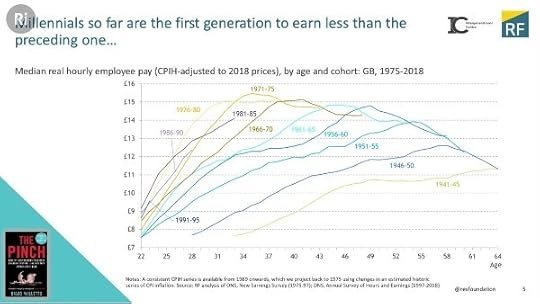
In the speech David Willetts uses the graph to show that for the first time younger generation’s income is lower than previous generation. However I find that the most interesting part of the graph is how it shows that peak income for each generation arrives at a younger age. For people born in the late 1940s just after WW2, it happened in their late 50s; for people born in the late 1960s, when they reach about 40. This all points to a ‘peak income’ sometimes in the decade 2000-2010 with income decreasing later for all.
This observation explains why those that arrive now on the employment market won’t find the same level of opportunities. It is also a question mark about current income levels – across all generations.
Therefore the interpretation of the graph is rather that there is a general loss of income in the last decade. It impacts the start of millennials’ careers as well as all other active generations. This is the key issue that needs to be tackled, rather than inter-generational transfer issues.

June 13, 2020
How the Collaborative Age Requires A New Leadership Mindset
This MIT-Sloan paper ‘Leadership Mindsets for the New Economy‘ takes the perspective that the new economy requires a shift in leadership practices.

It starts with the excellent quote by Patty McCord, former chief talent officer, Netflix: “In today’s world, everyone has to adopt a leadership mindset. We have to think of ourselves as members of a leadership community“. This means that it is recognized that in the collaborative age, leadership capabilities need to be more widely spread inside organisations.
I find the rest of the paper a bit disappointing and too MBA like, with the identification of four key traits of leaders in the modern economy – producers, investors, connectors, and explorers. It does not go back to the question of how to make everyone in the organisation a leader – and how to make sure everyone plays the part he or she is the best about among those four traits. And that’s clearly the most important.
While this issue is recognized (“building a collective leadership capability is the strongest route to competitive advantage in today’s fast-paced world“), tomorrow’s determining leadership trait is indeed to allow the growth of leaders in all levels of the collaborative organisation. I’d rather see research exploring that direction.

June 11, 2020
How Excellence is a Moral Decision
In this Gapingvoid post ‘Creating excellence is not a job. Creating excellence is a moral act‘, the point is made that “Excellence is not a law of physics. Excellence is a moral act. You create excellence by deciding to do so, nothing more“

This means that excellence is what you do when no-one is looking, and it is a personal commitment. It can even become one way to define onself like Horst Shulze co-founder of the Ritz-Carlton Group is quoted saying “And life becomes much more valuable. It becomes much more fulfilling. It becomes something where you’re using your time to define yourself, and the first one who will see it and will be happy about it is you, yourself.”
This also means that striving for excellence can’t just be imposed from above by a manager. It is a real leadership act and requires leaders to demonstrate their commitment too in everything they do.
Excellence is not a quick recipe and a buzz word. It is a moral decision and requires strong leadership to spread.

June 9, 2020
How We Need to Be Fully Committed to a Limited Number of Intents
In the post ‘The Heartbreaking Effects of Being Only Partly Committed to Most Things‘, Leo Babauta exposes all the negative aspects of incomplete commitment. Partial commitment is however much more common than full commitment (remember gyms make a lot of money from people taking memberships and never showing up!).
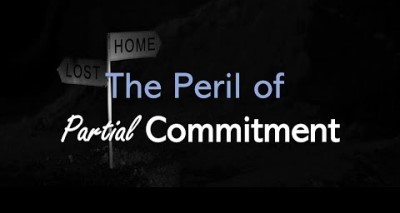
It is true that partial commitment leads to losing mental effort and investment. And it has negative consequences, including “[losing] trust in ourselves, beat ourselves up for failing again, create a negative self-image, which affects everything“, and possibly creating a negative spiral of non-achievement.
At the same time we can’t commit fully to everything, and in the portfolio of our many commitments, some will take the back seat and will have to be postponed. At any time, we anyway have only a certain limited amount of discipline and will.
I am not thus as negative as Leo Babauta on the issues of partial commitment. There are many more things we’d like to do than we can, and we also need to investigate new things. We can only be fully committed at any one time on a very limited number of projects. But it is true that we have to be fully committed to some. The issue is thus not to be partially committed to some projects, but rather if we are not fully committed to some of those.
What are the projects and intents you are fully committed to?

June 6, 2020
How Structure is Needed to Create a Safe Space for Disruptive Growth
I like this post by Charlene Li ‘Disruption Learnings from Self-Publishing a Book and Going to Burning Man‘, and in particular the part about the need for structure to achieve real disruption. Charlene Li is an experienced consultant specialized in disruption.
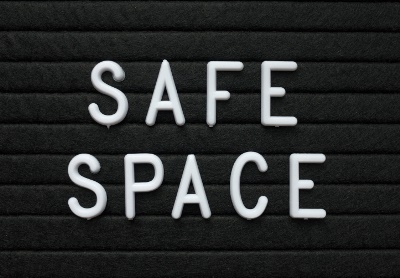
“One of the most interesting things I learned in my research for my book, “The Disruption Mindset,” is that disruptive organizations are incredibly well structured and ordered. When you don’t have to worry about how to get things done, then you can focus on achieving extraordinary, disruptive growth. You need to feel safe to take on risk, to be both vulnerable and confident in your ability to try and either succeed/fail. “
I find this insight very strong, as it shows that structure is actually needed for large scale change. People need to be able to focus on disruption and the rest needs to work perfectly, not losing time and effort. Messy organisations are not as likely to pull through a disruptive transformation than minimally organised ones.
“The takeaway is that you need to create just enough structure in your organization or community for people to feel safe space taking the first step out of their comfort zone. Your role as a leader is to ensure that this space remains steady for them, that it doesn’t wobble when they push off hard against it to take off on their disruption journey.”
The message is clear then: if you want to create a disruption, make sure you got the basics covered and organised, and create sufficient structure (and not too much) to enable proper focus on the change.

June 4, 2020
How We Will Increasingly Interact With Artificial Humans
The artificial human is on the rise, each with its own look and personality. No need to seek permission to use someone’s image anymore, the faces and personalities you’ll interact with don’t exist in the real world. And not only as pictures, soon in video as well, with the full range of emotions.
 None of these exist in the real world
None of these exist in the real worldOne aspect of it is brilliantly exposed in Seth Godin’s post ‘the End of Someone‘: endorsements have now no value. “In 2019, and perhaps forever, we’re now at a new level, one where the polish of photography or video is no longer any clue at all about the provenance of what we’re encountering. I don’t think we have any clue about how disruptive this shift is going to be“. Influencers wa may follow today sometimes don’t even exist (see our post ‘How Virtual Creatures Invade Our Connections and our World‘).
Like we, physical people, may today have several personalities in the virtual world, we’ll get increasingly mixed with purely virtual personalities. And it will become increasingly harder to distinguish one from the other. Fact-checking and source-checking is becoming an essential life and survival skill… as well certains skills to connect with AI-driven virtual humans, and maybe keeping the ability to connect face-to-face with real humans from time to time!
Welcome to the world of the virtual humankind. And a new increase in population, with the advent of a virtual set of humans!

June 2, 2020
How Navigation Apps Are Changing Municipal Traffic Policies
This post ‘Navigation Apps Changed the Politics of Traffic‘ explains how municipalities and local governments are adapting to the rise of navigation apps.
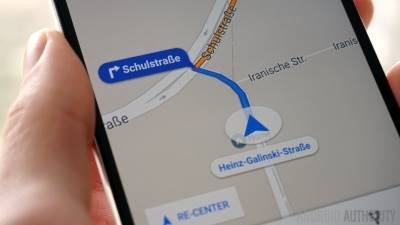
The issue is that those apps cater for the needs of the drivers, and not for the needs of the wider community. “Driver-first traffic “fixes,” even with the best of intentions, have deleterious effects on transportation networks overall.” There is a collective price of having each driver optimise its own route. “One widely cited 2001 paper by computer scientists at Cornell found that a network of “user-optimized” drivers can experience travel times equivalent to what a network of “system-optimized” drivers would experience with twice as many cars. Transport engineers call the difference between selfish and social equilibria the “price of anarchy.””
There seem to be some debate on the actual effect of those apps, and whether the algorithms also include some more collective constraints (one can remark for example that on two different phone, they may not give the same itinerary, showing that they try to spread congestion).
In any case as apps encourage the usage of smaller roads not normally used for transit, local governments act in restricting speed and transit possibilities in those smaller roads normally not planned for transit traffic. This has given a different priority to municipal policies. Other possible solutions is to install tolls for transit traffic or otherwise price mobility differently, or to change the overall traffic patterns.
It is just the start of the change of our urban landscape and mobility brought by real-time navigation apps. Expect physical changes and changes of usage.

May 30, 2020
How I Actually Am a Modern Artisan
As a consultant I realized I work as an artisan. An artisan in intellectual work, of course, but nevertheless an artisan. And I am perfectly happy doing this without trying to grow into an industrial approach.
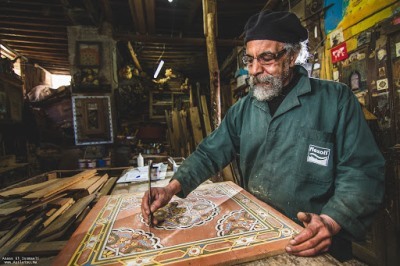 old-fashioned artisan
old-fashioned artisanIn my daily consulting work, I spend my time adapting my knowledge and material to my clients’ situations, polishing it with a view on excellence, never twice producing the same although every time it is similar; learning from master and from practice to deliver ever better solutions and insights.
Thus we should see today artisans in a much wider sense than the usual touristy ‘artisan craft’ of old-fashioned love for manual work. And there are actually many artisans all over the modern world putting their love of things well done in their creations for needing clients. There are many more artisans that what you’d believe. And everyday I discover new small niche companies providing artisan-ware and services to many different parts of our societies.
Artisans are not disappearing, they are rather thriving in the new collaborative work as it allows them to have a wider audience and thus sustain their work. It co-exists with industries that are also needed to deliver the benefits of scale. Still we need dedicated artisans, and I am one of them.

May 28, 2020
How We Need to Remember that Extreme Stress Creates Diamonds
I love this quote “In times of extreme stress, just remember that pressure makes diamonds.” I’m not sure who to attribute it to, but it’s quite inspiring.
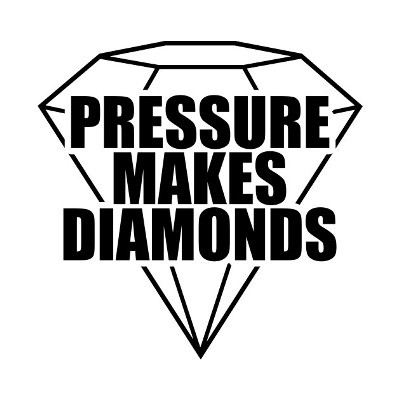
This serves to remind us that we are often mainly shaped by hard times rather than smooth times. Therefore albeit difficult in the present moment, highly stressful situations will transform us.
Hopefully, of course, this transformation will be for the better (extreme stress and pressure can also create stuff that is less nice than diamonds!).
Still it is a good reminder that we can get positively transformed by periods of intense pressure and stress. Keep it up!




